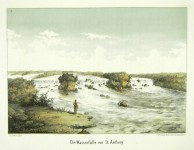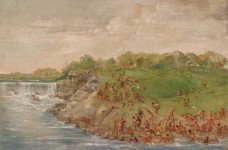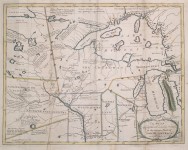Dakota and Ojibwe peoples’ relationship with their homelands is rooted in cultural history and spirituality, including a powerful sense that they are related to everything that surrounds them. The Dakota express this as mitakuye owasin, “all my relatives.” This profound connection with their land includes a responsibility to maintain balance by caring and providing for one another. Throughout history, this connection established a Native nation’s sovereignty in their territory.
Mitakuye owasin . . . is an acknowledgement of all that has ever been created, in the entire universe, as your relative. To nod your head in acknowledgement to a rock or a blade of grass and to think of that rock or that blade of grass as your brother and to call him brother.
— Tammy DeCoteau (Sisseton–Wahpeton Dakota), 2004
Bdote Minisota: Homelands of the Dakota Sioux
Many Dakota trace their origins to the junction of the Minnesota and Mississippi rivers, the area near present-day Minneapolis–St. Paul. The region surrounding the confluence of the rivers, including the Falls of St. Anthony, is sacred to many Dakota as a place of their emergence into the world. In the Dakota language, this place is called Bdote, “where the two waters come together.” The word “Bdote” is familiar to many Minnesotans in its English version, “Mendota.”

The Falls of St. Anthony (detail), by Henry Louis, 1857. | Courtesy The Newberry Library, Chicago. Call Number: Ayer 160.5 M76 L6 1857
The Great Ojibwe Migration
Some Ojibwe oral traditions tell of a great westward migration from the Atlantic Ocean, down the St. Lawrence River, and through the Great Lakes in search of a prophesied place “where food grows on the water.” The quest led them to northern Minnesota, where the Ojibwe found abundant wild rice growing in shallow lakes and waterways.

George Catlin, Ojibwa Portaging Around the Falls of St. Anthony, 1835–1836. | Courtesy Smithsonian American Art Museum | Gift of Mrs. Joseph Harrison, Jr. 1985.66.465
A Place Called Home
Dakota and Ojibwe people understood the need to have a place to feel secure, have access to food, and visit sacred sites. For the tribes, territory was not about money or property. It was about tradition—about maintaining a way of life and a place called home.
This map shows Dakota and Ojibwe lands in the future state of Minnesota circa 1768. Dakota villages are shown at left as “Naudowessie Country” and Ojibwe (who have also been known as the Chippewa) villages are located at right center as “The Chippeway Territories.”

Dakota and Ojibwe Lands, ca. 1768. Jonathan Carver, from Travels through the Interior Parts of North-America in the Years 1766, 1767, and 1768, 1778. | From the James Ford Bell Library, University of Minnesota










